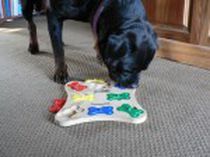Providing Mental Stimulation for your Dog by Taryn Blyth
18 August 2014Many dogs engage in destructive behaviours or appear hyperactive, because they do not have enough to stimulate them and keep them occupied. Dogs that were originally bred for working purposes have a particular need to "do stuff". It is often suggested that the way to handle active or destructive dogs is to provide more exercise. While daily walks are recommended for all dogs, increasing physical exercise is not always the answer to destructive or hyperactive problems. In some cases it only results in a fitter dog that has more energy to be destructive or hyperactive at home. In many cases what the dog actually needs is increased mental stimulation and not increased physical exercise.
Walks can be an important way of providing mental stimulation, but to do so they should contain at least some of the following opportunities for the dog:
Opportunities for social contact (meeting dogs and people)
- Opportunities for play - either with the owner, with toys or with other dogs
- Opportunities for sniffing and exploring i.e. the dog cannot be kept on lead all the time and dragged past anything it finds interesting without the opportunity to investigate it
- Opportunities for training - owners should practice training exercises on walks or games where the dog has to work to find a reward e.g. hiding a toy for the dog to find.
However, owners should also provide mental stimulation for dogs at home. Good ways to do this are as follows:
- Introduce chew toys like raw-hide, stuffed hooves or Kongs (filled with the dog's own food - in fact all meals can be fed from Kongs instead of fed in a bowl) so that the dog has to work to get its food and focuses its energy on chewing appropriate objects rather than other things around the house.
- Provide interactive toys which require the dog to think to solve problems and gain rewards e.g. buster balls (they have to roll them around for food to fall out). You can make your own "brain toy" by getting a muffin tray, placing a treat in the bottom of each cup and then filling each cup with a tennis ball. The dog has to learn to remove the tennis balls to get the treats. After a while the treats can be hidden under only two or three balls so that the dog has to work harder to find them.
- Play hide and seek with toys and treats around the home i.e. put the dog in a stay position and hide the toy or treat in another room, then send the dog to go and find it. Seeking games give dogs an opportunity to use one of their most powerful sense organs - the nose!
- Have 5 minute training sessions once or twice a day. Think of all the clever things you can teach your dog to do, like fetch socks you have dropped on the way to the washing machine, close cupboard doors (by learning to nudge the door with their noses) and pack away the recycling (dropping empty plastic containers into a basket).
- For herding breeds one can buy large gym or Pilates balls and encourage the dog to herd them around the garden.
Unfortunately, many dog owners have recently invested in treadmills as a result of advice from a popular TV show, but this is really not a suitable way to keep a dog occupied. Besides the danger and outright cruelty involved in tethering a dog to a treadmill, this type of activity provides absolutely no mental stimulation for the dog. (Which is why most humans who use this type of equipment do so while listening to the radio or watching the TV!)
So, try to regularly provide activities that engage not only the physical side of the dog, but the brain and senses as well.

